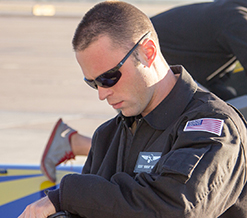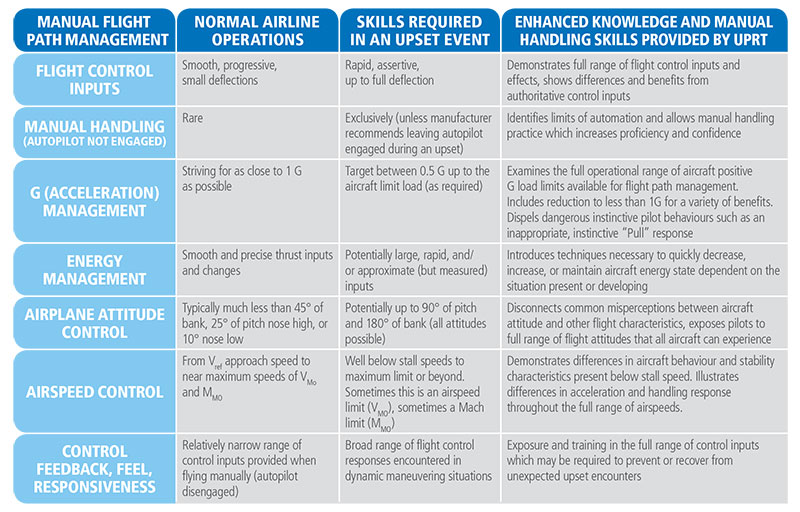Summary
 Manual flying can be described as intrinsic flying ability, assumed, at least by the flying public, to be part of the skill sets of all commercial pilots. If present, even innate skills can be improved upon, polished, and expanded. If these skills are not present, they can be learned. Manual handling flying skills include everything from basic instrument reference and simple flight control inputs to complex problem solving in a crew environment when time is of the essence. Upset prevention and recovery training is aimed at improving and building upon these basic skills, and teaching new ones for the unexpected.
Manual flying can be described as intrinsic flying ability, assumed, at least by the flying public, to be part of the skill sets of all commercial pilots. If present, even innate skills can be improved upon, polished, and expanded. If these skills are not present, they can be learned. Manual handling flying skills include everything from basic instrument reference and simple flight control inputs to complex problem solving in a crew environment when time is of the essence. Upset prevention and recovery training is aimed at improving and building upon these basic skills, and teaching new ones for the unexpected.
Author Scott “Bonsai” Dieringer, APS Advanced Instructor Pilot
Originally published in Skies Magazine
Overview Video
A longer version video is available at the end of the White Paper below.
White Paper: Does UPRT Really Enhance Manual Handling Skills in Professional Pilots?
Download: Skies Magazine Article – Manual Input
Introduction
Imagine yourself in the right seat of a Boeing 737 airliner cockpit. A cabin full of passengers depends on you and the captain to take them safely to their destination. A gaze through the windshield during a routine decent reveals a blanket of white clouds underneath you as far as the eye can see. The day has been uneventful from the moment you woke up. Shattering this quiet reverie, you begin to encounter light chop – the turbulence seems to be escalating. The Captain turns on the seat belts sign and directs the flight attendants to take their seats. Sudden unexpectedly heavy turbulence takes you by surprise, the aircraft rolls. It reaches 45 degrees of bank and the nose begins to fall as the captain deactivates autopilot and initiates aileron and rudder inputs to counter the disturbance… The aircraft does not respond…
This is the scenario the crew of United Airlines Flight 578, a Boeing 737 bound for Chicago from St. Louis, found themselves in on that day in December of 2001. At this point, the crew is hand-flying an aircraft full of people without the aid of autopilot or automatic power adjustments. In other words, they are relying on manual handling skills in this unexpected upset event that are significantly different from their day-to-day manual flying skills.
Manual Handling
Manual handling skills, according to the International Civil Aviation Organization (ICAO) Manual on Aeroplane Upset Prevention & Recovery Training, are appropriate pitch, power, roll, and yaw inputs made to avoid or correct undesired flight path deviations and to arrest any divergence to avoid, prevent, or recover from an upset. These manual flying skills are the foundation for all pilot skills in the early stages of training, but are increasingly atrophying in today’s age of advanced, highly automated aircraft. Acquiring a vital understanding of the aerodynamic effects that occur beyond the normal flight envelope, and the use of assertive, potentially full-deflection control inputs required in airplane upset situations are not part of civil training requirements for airline pilots today.
Manual flying is generally thought of as those flying abilities a pilot uses to fly the aircraft only by reference to the raw data presented in the forms of airspeed, attitude, altitude, vertical speed, and so-on through direct manipulation of the controls without the aid of automation. This automation includes, but is not limited to, autopilot systems, autothrottles, and the variety of flight management systems (FMS) currently equipped in many modern-day aircraft. These skills include complex problem solving in a crew environment with time as a critical factor. Basic navigation equipment usage and manual trim adjustments can be considered manual flying as well, depending on the sophistication of the equipment. Taking this a step further, especially as it relates to modern aviation, a pilot’s flying technique may combine the above mentioned manual flying skills with combinations of automatic speed and direction control and guidance. These combined inputs usually occur through individual pilot habit patterns or preferences, procedural requirements, operational standards, or when automated systems fail. The latter of these instances, the failure of automation, is a circumstance that is rare but is cited as a contributing factor in several recent and deadly crashes. The failure of automation, or perhaps even worse, degraded modes of automatic flight make the pilot’s manual handling skills incredibly important, and are often the decisive factor between life or death.
Case Studies
Examination of some recent fatal accidents in the industry can provide valuable insight into the importance of manual handling, especially for pilots flying more sophisticated aircraft with advanced flight control and automation systems.
China Airlines Flight 140
The first example, China Airlines Flight 140, an Airbus A300-600R, crashed on an approach to Runway 34 at Nagoya Airport, Japan on April 26, 1994. The co-pilot, after several inappropriate activations of the go-around mode on approach and several subsequent cautions from the captain, inadvertently selected the Take-off/Go-around (TOGA) mode on approach. The aircraft pitched up and immediately stalled, which led to loss of control and tail-first impact with the ground. The crew failed to recognize the stall, or apply appropriate manual handling skills on a manual approach. The crash killed 264 and injured 7 more (Nakao, n.d.).
Colgan Air Flight 3407
The second mishap is much more recent. On February 12, 2009, a DHC-8-400 operated by Colgan Airlines on a codeshare agreement with Continental Airlines crashed into a residential area while on an ILS approach at night in VMC. The aircraft entered a stalled condition due to improper power settings and airspeed control, and the crew reacted by pulling on the control column, which increased the angle of attack further and worsened the stalled condition. Following this inappropriate reaction, the crew lost control of the aircraft which resulted in a fatal crash that killed all 50 aboard and one person on the ground (NTSB, 2010).
Air France Flight 447
Finally, and much more publicized worldwide, is the crash of Air France 447 (AF447), an Airbus A330-200 that departed Rio de Janeiro, Brazil on June 1, 2009 and crashed into the Atlantic Ocean enroute to Paris, France. After a two-year long, multi-national effort to find the crashed aircraft at the bottom of the ocean, the wreckage was finally recovered. A loss of airspeed sensing resulted in the aircraft’s fly-by-wire system degrading to a mode of control with fewer protections than the crew was used to having. At an altitude of 35,000 ft, the aircraft stalled, and the crew responded with a pull on the control stick and maintained the pull, holding the aircraft in the stalled condition for over four minutes until impact with the water. The crash killed all 228 aboard (AHRTP.com, 2012).
Repercussions of recent manual handling related mishaps
These are sobering examples of sophisticated aircraft ending up destroyed with massive loss of life in large part due to the lack of manual handling skills of crewmembers faced with a degradation of their normal automatic mode of operation. Although there is seldom just a single causal factor to any accident, the loss of control, that made these accidents so horrific would most likely never have occurred had the pilots been better prepared to take over manually. So, it becomes painfully clear that manual handling as described earlier is a critical dimension of the professional pilot’s skill sets. The public outcry over the discovery that AF 447 went down as a result of a loss of control inflight exacerbated by an inappropriate crew response accelerated a long overdue response from the industry set in motion by the Colgan accident. Andy Pasztor of the Wall Street Journal (2011) wrote “The latest revelations, according to safety experts and others familiar with them, are likely to add to pressure to revamp training practices to help both new and experienced pilots cope with high-altitude stalls, upsets and faulty airspeed sensors…” The accident spawned a broad reappraisal of pilot training, examination of the undue reliance on automation, and the conclusion that the incident could have been avoided had the pilots received more training in manual flying and stall recognition (Pasztor, 2011).
Competencies
The International Airline Transport Association (IATA) recognizes eight core competencies required by today’s airline pilot, ranging from communications to leadership. All have direct, transferable application to the type of in-flight upset scenario described. Although all competency areas have specific considerations in the face of an unanticipated upset event, no competency is as dramatically affected as is the competency of “Aircraft Flight Path Management by Manual Control.”
Unfortunately, some of the ways that manual handling skill requirements are influenced by an aircraft upset are counterintuitive and may not fully make sense to a pilot who has not been in that situation before. This is where a new segment of flight training which has appeared in the last two decades comes to the fore. Upset Prevention and Recovery Training (UPRT) is flight training focused on addressing the academic knowledge and practical skills necessary to properly deal with an upset event.
Skills and Needs
The table below summarizes critical points as they relate to IATA’s “Aircraft Flight Path Management by Manual Control” competency, clearly showing the contribution that UPRT provides in enhancing the ability of pilots to safely negotiate a broader range of situations which could result in loss of control of the aircraft.

As the chart shows, skills required during Normal Airline Operations are significantly different, and in some cases opposite, of the skills required in an upset event. While there may be times when crews practice more abrupt control movements (V1 cuts, nose low unusual attitudes), there are very few times they actually use these inputs. The proficiency gained through comprehensive and focused training specific to the upset environment provides the Enhanced Knowledge and Manual Handling Skills Provided by UPRT as a safety net for pilots if confronted with an escalating upset event which was not successfully prevented through awareness and avoidance.
Upset Prevention and Recovery Training
Step 1: Specialized classroom instruction
Recognizing the increased threat of Loss of Control In-flight accidents (LOC-I), ICAO has made recommendations regarding proper UPRT in a manual on the subject published last year. The first step in the process is an expansion of what can be termed “book knowledge” by examination and review of those aerodynamic factors that apply to all fixed wing aircraft. Classic stall recognition techniques are covered, exploration of applicable performance charts relating load factor, bank angles, velocity, and other aerodynamic subjects is conducted, and case studies highlighting proper and improper use of recovery procedures are detailed. This portion of UPRT is absolutely vital and sets a solid foundation for understanding why prevention and recovery steps are designed the way they are. Armed with this knowledge, the UPRT pilot in training is equipped to execute on-aircraft training using the techniques and strategies covered in the classroom.
Step 2: On-aircraft UPRT maneuver training
Comprehensive UPRT then combines this academic knowledge with on-aircraft flight training in an appropriate aerobatic aircraft. The all-attitude maneuvering capabilities of aerobatic aircraft allow the development of mental models for aircraft behaviors outside of the normal envelope. This practical skill development leads to pattern recognition which can help to prevent developing upsets and, if necessary, recover safely.
An aerobatic-capable aircraft is recommended by several different regulatory agencies including the FAA and the International Civil Aviation Organization (ICAO). They recommend conducting on-aircraft UPRT in aerobatic category aircraft to expose pilots to maneuvers such as uncoordinated stalls and spiral dives which would, in a normal or transport category aircraft, put the crew at high risk to enter spins or other loss of control inflight events that could be unrecoverable due to the decreased safety margins in those aircraft types. Aerobatic aircraft have a much higher safety margin and ability to conduct all-attitude and all-envelope training than other aircraft types, particularly transport category airplanes.
This point begs the question: “Can jet pilots really learn UPRT in a single-engine piston airplane?” The answer is in the question itself. A jet is an airplane, subject to the same general aerodynamic laws as a single engine piston aircraft. Granted, each has differences in pitch moments with power changes, keel effect, turning tendencies and yaw damper considerations among other things, but these differences make up an estimated five percent disparity between aircraft types. With that said, the training industry agrees that type-specific considerations are critical to effective UPRT skill development and must be comprehensively addressed during type-rating and recurrent training. Overall, an airplane is an airplane, and virtually all pilots begin their careers in the same kind, a single engine piston airplane. Upset training is intended to be transferable, it should follow a pilot through his or her career, and thus the tenants taught during early training should be relatable to any fixed wing aircraft. That said, an aerobatic aircraft is clearly more maneuverable than other aircraft types, has higher load factor limits, G-force onset rates, smaller turn radii, faster roll rates, and so on. However, most pilots of less maneuverable or more limited categories never truly see their aircraft (or any other for that matter) at the limits of or beyond what they consider “normal” flight parameters. The closest most get to these parameters is the approach-to-stall indications during their once-a-year recurrent simulator sessions. They would never dream of using maximum aileron deflection or pushing on the control column or stick before and while rolling out of an upset. Accomplishing these techniques and many more techniques exclusive to UPRT expand the pilot’s awareness, learning horizons, aerodynamic understanding, practical experience, and edge-of-the-envelope experience.
Step 3: Full Flight Simulator UPRT exposure
As the last component of the UPRT triad recommended by ICAO, flight simulators are then used to practice these newly learned skills in an environment more representative of the professional pilot’s normal operating environment than a typical aerobatic-capable aircraft and helps them to correlate the aerodynamic lessons they’ve learned during UPRT apply to their own aircraft or one of a similar type or category. Furthermore, crew resource management is tested and UPRT is applied in this kind of environment, because manual flying doesn’t always apply to only the pilot flying, but his or her crewmember(s) as well.
Don’t Become a Statistic
The crew of United 578 saved their aircraft and all aboard by applying appropriate upset recovery techniques as a team, particularly by doing something that is largely counterintuitive: they pushed to increase the effectiveness of their roll control.
All too often during traditional flight training, stalls and upsets are treated as scripted events, where the set up and approach to the maneuver demands more focus than the recovery itself. A pilot untrained on upset prevention and recovery possesses manual handling skills acquired from their training. This training in most cases is designed to satisfy the respective national aviation authority testing standards in the country of training for certification of piloting licenses. Great emphasis is placed on procedures used to prepare and configure for a very limited set of stalls and unusual attitudes. Rich Stowell, a multiple-time Master CFI-Aerobatic and published flight training author, states “Treated as an independent maneuver unto itself, the whole ordeal is often enveloped in unnecessary melodrama as well. The actual lessons learned, however, are fear and a false association between the stall and slow airspeed.” As a result, all too often a poor and dangerous strategy may develop that seems quite plausible: fly faster to provide a larger margin against these stalls that are misunderstood and are perceived as frightening (Stowell, 2006). This shows an inherent weakness in UPRT-deficient pilots, or more succinctly stated, a gap of knowledge on a critical portion of an aircraft’s performance—the stall, which is the leading cause of Loss of Control In-flight. UPRT seeks to close that gap, to fill in those missing pieces of learned manual handling ability through various means.
During their regulatory training, pilots may have met all the requirements of existing training and have been skilled in the aerodynamic region that they operated in normally on a daily basis, but the manual handling skills required in an upset can be significantly different from the manual handling skills used day-to-day. With the critical window of time available to prevent or recover from an airplane upset, crucial UPRT skills must be learned in advance so they are available if required. To that point, ICAO has recommended that all pilots receive training in UPRT “in actual flight” prior to Commercial licensing. To quote Louis Pasteur, “Chance favors the prepared mind.” Regardless of the particular aviation authority, it is accepted by an ever growing consensus that it is time to enhance the manual handling skills of professional pilots through comprehensive UPRT.




Comments: